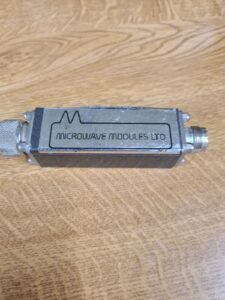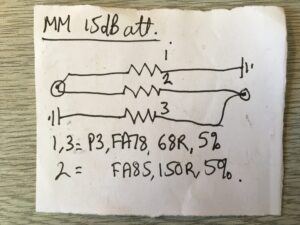The Microwave Modules MMT1296 and other transverters, rely on a 15dB attenuator between the transverter and the driver radio for matching. When these transverters were designed, 10W output base and mobile transceivers were the norm.
When you buy a second hand transverter, these attenuators are often missing. I had a similar experience and wondered what Microwave Modules had used to build them. My MMT1296 required a 2m / 144MHz radio to drive it.
On the right is an image of one of the attenuators Microwave Modules supplied, it’s a simple die cast box with a chassis plug on one end and a socket on the other. You simply screwed it into the ‘Transceiver’ socket on the transverter and then screwed the lead from your transceiver into the attenuator. The MMT1296 used a 15dB module, 10dB and 5dB were also available.
I did take a picture of the inside of one of these attenuators but can’t find it. I did however make a drawing of the circuit diagram. There were three non-inductive wirewound resistors of around 10W power handling each…they looked like normal wirewound resistors and there was no internal screening. Quite a basic setup but it worked. There were two 68 ohm resistors and one 150 ohm resistor, robustly soldered to the tags inside the module. The 68 ohm resistors were marked Type FA78 and the 150 ohm resistor, type FA85.
Sometimes empty module boxes turn up at radio rallies, so you could build you own. I came across a useful calculator for Pi attenuators which calculates the exact value for each resistor. You will of course, need to use the nearest standard value, unless you need perfect accuracy and then a combination of resistors will be needed.
The calculator is here.
The calculator worked out the resistance values for a 50 ohm impedance, 15dB attenuator, to be 136.14 ohms and 71.629 ohms. Using the standard values as in the module, the attenuation is 15.92dB which is close enough for amateur work.
The calculator will allow you to input resistance values and calculate the attenuation, or you can insert the desired attenuation and generate the resistance values.

